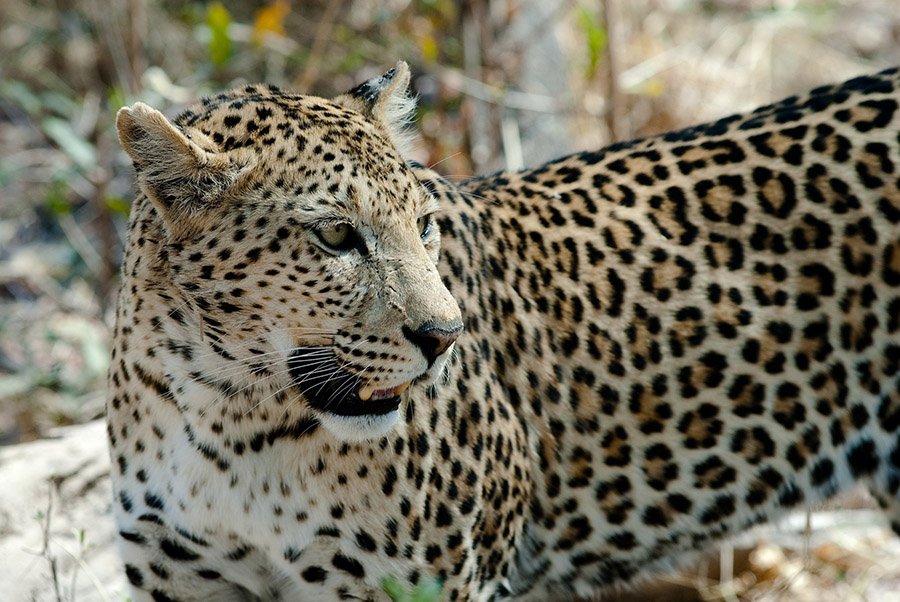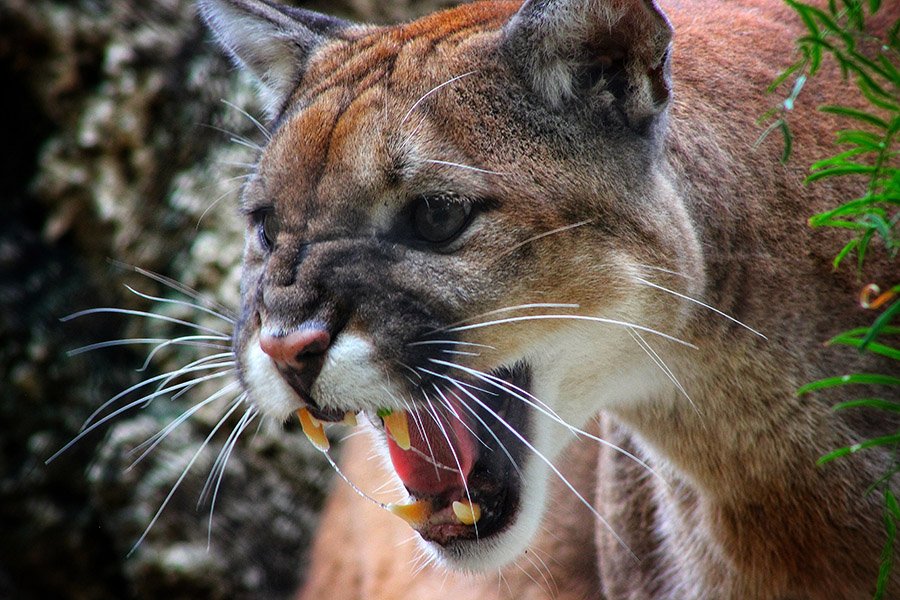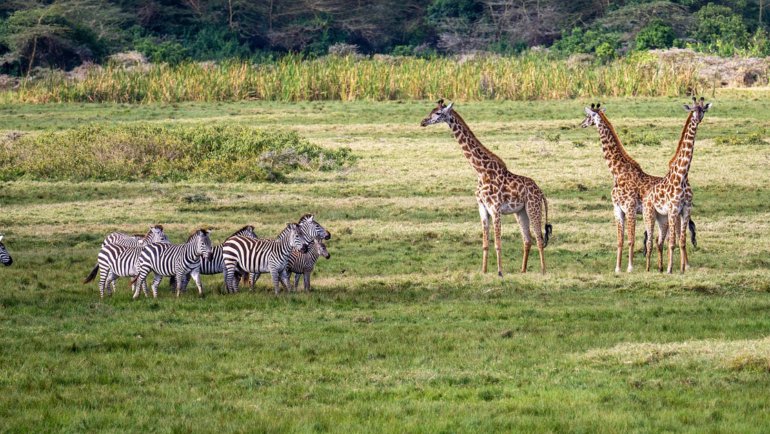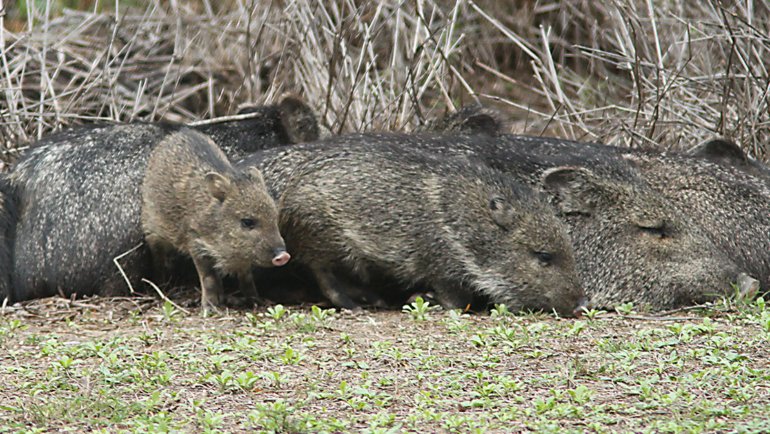Although leopards and cougars exhibit some common characteristics, such as being referred to as panthers and their ferocious predatory character, there are plenty of differences that distinguish them.
Fortunately, this article will enable you to understand them better by highlighting and contrasting their unique features. Based on scientific facts, I will also inform you which animal would win in a leopard vs. cougar fight.
The Differences Between a Cougar and a Leopard
Size
Cougars/mountain lions are larger in terms of their overall body size, although leopards have a higher body length than the latter. The average length of an adult cougar, from head to body, is approximately 3-6 feet (36-76 inches), while its tail is 2-3 feet (24-36 inches) long.
On the other hand, the average length of a leopard is 4-7 feet (48-84 inches), and its tail is 2-3.5 feet (24-42 inches) long.
One of the main reasons why the mountain lion is bigger than the leopard is their long legs, making it appear much taller.
Their hind limbs are longer and more muscular than their front legs, which makes their behind appear raised compared to their shoulders.
The average height of a cougar is 23-35 inches tall at the shoulders, while the leopard is 21-28 inches tall in shoulder height. The leopard’s body is symmetrical since its front and hind limbs are almost the same height.

Weight
As previously stated, cougars are bigger than leopards. The other reason (apart from height) contributing to this factor is their significant weight.
Typically male mountain lions weigh more than females, with an average weight of 110-243 lbs (50-110 kg), while females weigh 77-176 lbs (35-80 kg).
The same case applies to leopards since males weigh more than their female counterparts. It’s essential to note that its habitat’s location also influences the leopard’s weight. For instance, an African leopard’s average weight differs from an Asiatic one.
However, the general body weight of all male leopards, despite their background differences, ranges from 70-220 lbs (32-100 kg), while females weigh 65-200 lbs (30-91 kg).
Strength
By now, it’s obvious that mountain lions/cougars are stronger than leopards due to their significant height and weight levels. Cougars are also classified as the fourth largest cats, after tigers, lions and jaguars.
Physical Appearance
The most significant difference between the two, a cougar and a leopard, is their physical appearance.
Mountain lions are typically covered with golden yellow fur, apart from their bellies and chests, which are whitish-grey. The base tips of their tail, ears, and nose have light black spots.
Leopards are covered in beautiful white fur with black spots all over their bodies. The top part of their nose is golden yellow, but the tip has light black spots.
Although most people assume that the black panther is a different cat species, it’s essential to note that the feline is also a leopard. Their name is due to the dark/black fur covering its body.
Also read: Hyena vs. Leopard: Key Differences & Who Would Win a Fight?

Geographical Distribution and Habitat
The main natural habitat of mountain lions is in the terrestrial climatic regions of North and South America. Although they are highly concentrated in the western states of America, their geographical distribution extends to the northern parts of the Canadian Yukon.
Of all the wild cats, leopards have the most widespread global distribution, depending on their subspecies. For instance, the desert leopard’s habitat is in the semi-arid regions of Israel and the Middle East.
On the other hand, the snow leopard is only present in the cold regions of Central Asia (India, China, Thailand, Malaysia, Vietnam, Nepal, and Indonesia). However, most leopards prefer regions with trees, such as the African rainforest and savanna areas.
Also read: Are There Leopards in the Jungle?
Behavior
Cougars are territorial and solitary animals, meaning they spend most of their lives alone in their specific habitats, except when mating. They mark their territories using their urine or scratching the surrounding vegetation, such as tree barks, with their claws.
When a cougar is fortunate in securing a large prey, they often share their kill with their neighboring cougars. As a show of gratitude, the other cat will occasionally return the favor when it’s their time
Females spend the first two years with their young cubs. But, as soon as they show signs of maturity, their mother abandons them so that they can live on their own.
Young mountain lions usually hunt smaller prey like insects, wild rodents, rabbits, and smaller/younger deer. As they grow older, their nutritional requirements, confidence, and strength increase, enabling them to hunt larger animals.
Leopards are similar to cougars since they are also solitary and territorial animals. Unlike the cougars, which don’t have any predators, these cats face a significant threat from the larger cats, especially lions, which tend to kill them and, at times (during food scarcity, although it’s rare), eat them, mainly their cubs.
Due to the stiff competition and threat from bigger cats, leopards drag their prey’s carcasses on top of trees to secure their food. They also prefer smaller prey like young gazelles, which are easier to hunt since these cats are neither very strong nor faster than other felines.
Also read: Do Tigers Eat Leopards? A Complete Answer

Cougar vs. Leopard: Who Would Win The Fight?
Although the chances of witnessing a cougar vs leopard fight are highly unlikely; it’s safer to place your bet on the cougar as the winner.
The mountain lion’s significant size, body weight and strength will assist it in the duel. But, it’s certain it would also sustain serious injuries despite its victory since the leopard is a vicious, strong, brave cat.
Frequently Asked Questions
Cougar vs. Puma vs. Mountain Lion
The Puma concolor (its scientific name) is currently ranked as the cat with the most names referring to the same species. The names depend on the geographical location.
For instance, in Central and North America, the animal is called the ‘mountain lion’, while in South America, it’s a ‘cougar.’
Mountain Lion vs. Snow Leopard
Some of the basic differences between a mountain lion and a snow leopard are:
The mountain lion/cougar belongs to the genus puma. Its scientific name is Puma concolor, while the snow leopard belongs to the genus Panthera; its name is Panthera uncia.
Cougars are mainly found in North, Central, and South American regions, while snow leopards are present in Central Asia.
Snow leopards have longer tails compared to mountain lions, with an average length of 2.7-3.9 feet (32- 47 inches), while the mountain lion’s tail is 2-3 feet (24-36 inches).
Mountain lions are adaptable to multiple climatic conditions and habitats such as; grasslands, tropical rainforests or semi-arid climatic regions. Snow leopards only thrive in areas with low temperatures, cold and snow.
Final Thoughts
Despite both cats sharing the same name, panther, and several characteristics, you are now aware that they are different felines with significant differences.
You also know who would emerge as the winner in a leopard vs cougar combat. Therefore, if you happen to witness this fight, remember the facts stated in this article as you place your bet. It will increase your success chances.



